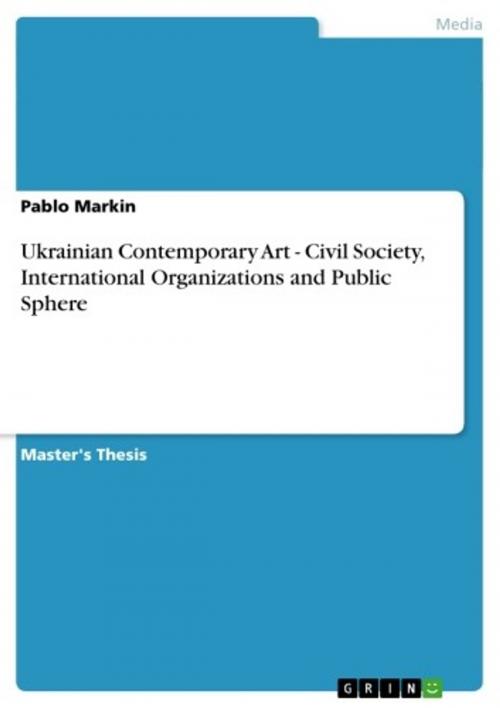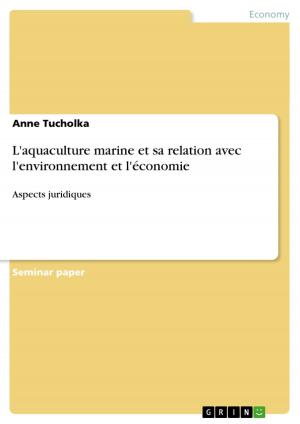Ukrainian Contemporary Art - Civil Society, International Organizations and Public Sphere
Nonfiction, Art & Architecture, General Art| Author: | Pablo Markin | ISBN: | 9783640254804 |
| Publisher: | GRIN Publishing | Publication: | January 28, 2009 |
| Imprint: | GRIN Publishing | Language: | English |
| Author: | Pablo Markin |
| ISBN: | 9783640254804 |
| Publisher: | GRIN Publishing |
| Publication: | January 28, 2009 |
| Imprint: | GRIN Publishing |
| Language: | English |
Master's Thesis from the year 2003 in the subject Art - Miscellaneous, grade: 87, erg International School - Hebrew University of Jerusalem, Israel (Helmut Kohl Institute for European Studies), 54 entries in the bibliography, language: English, abstract: The independence of the countries that have succeeded the Soviet Union in 1990s has created basic conditions for the institutionalization of the civil society in these states. Ukraine has joined these newly independent states with little reliance on the institutions of the civil society. The developments within the Ukrainian art reflect the implications that the failure of the civil society institutionalization has for this particular domain of Ukrainian society. Ukrainian contemporary art that is presented at the major international art museums and art festivals of the contemporary art is a post-Soviet phenomenon that occupies the junction between Ukrainian art, international institutions and civil society. As a field of artistic activity Ukrainian contemporary art strives to differentiate itself from Ukrainian art that originated in the environment largely formed in the pre-independence, Soviet period. The struggles for authority within the field of Ukrainian contemporary art have involved Ukrainian institutions that are outside of it. Both institutional and personal agency within the field of Ukrainian contemporary art is affected by the lack of institutionalized civil society in Ukraine. In the theoretical terms of Pierre Bourdieu it is the case of the lack of autonomy that the field of Ukrainian contemporary art has. The sought-for autonomy would allow the field of Ukrainian contemporary art to exercise control over the resources of artistic authority. How this finds its articulation in the personal narratives of the major Ukrainian contemporary art figures and in the conflicts that happen in the field of Ukrainian contemporary art is the topic of this research. The methodology of multi-sited anthropology adopted in this research makes it possible to trace the contours of the authority relationships among contemporary artists, art institutions and curators at the time of inquiry. The research draws on twenty in-depth interviews arranged in 2001 with the leading figures of the Ukrainian contemporary art, with the prominent art curators that cooperate with the Ukrainian contemporary artists, and with the representatives of the major contemporary art galleries and foundations of Ukraine.
Master's Thesis from the year 2003 in the subject Art - Miscellaneous, grade: 87, erg International School - Hebrew University of Jerusalem, Israel (Helmut Kohl Institute for European Studies), 54 entries in the bibliography, language: English, abstract: The independence of the countries that have succeeded the Soviet Union in 1990s has created basic conditions for the institutionalization of the civil society in these states. Ukraine has joined these newly independent states with little reliance on the institutions of the civil society. The developments within the Ukrainian art reflect the implications that the failure of the civil society institutionalization has for this particular domain of Ukrainian society. Ukrainian contemporary art that is presented at the major international art museums and art festivals of the contemporary art is a post-Soviet phenomenon that occupies the junction between Ukrainian art, international institutions and civil society. As a field of artistic activity Ukrainian contemporary art strives to differentiate itself from Ukrainian art that originated in the environment largely formed in the pre-independence, Soviet period. The struggles for authority within the field of Ukrainian contemporary art have involved Ukrainian institutions that are outside of it. Both institutional and personal agency within the field of Ukrainian contemporary art is affected by the lack of institutionalized civil society in Ukraine. In the theoretical terms of Pierre Bourdieu it is the case of the lack of autonomy that the field of Ukrainian contemporary art has. The sought-for autonomy would allow the field of Ukrainian contemporary art to exercise control over the resources of artistic authority. How this finds its articulation in the personal narratives of the major Ukrainian contemporary art figures and in the conflicts that happen in the field of Ukrainian contemporary art is the topic of this research. The methodology of multi-sited anthropology adopted in this research makes it possible to trace the contours of the authority relationships among contemporary artists, art institutions and curators at the time of inquiry. The research draws on twenty in-depth interviews arranged in 2001 with the leading figures of the Ukrainian contemporary art, with the prominent art curators that cooperate with the Ukrainian contemporary artists, and with the representatives of the major contemporary art galleries and foundations of Ukraine.















